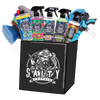Built for workshop bays, detailing studios, and mobile fleets, the 20L Wheel Wash delivers serious cleaning power where it matters most on wheels coated in brake dust, road grime, and oxidised residue. Safe on all factory finishes, this ready-to-use acid-free formula breaks down contaminants fast without damaging your rims.
Whether you’re cleaning alloy wheels on sedans, steelies on work utes, or powder-coated 4WD setups, this drum gets the job done with commercial efficiency.
Built for workshop bays, detailing studios, and mobile fleets, the 20L Wheel Wash delivers serious cleaning power where it matters most on wheels coated in brake dust, road grime, and oxidised residue. Safe on all factory finishes, this ready-to-use acid-free formula breaks down contaminants fast without damaging your rims.
Whether you’re cleaning alloy wheels on sedans, steelies on work utes, or powder-coated 4WD setups, this drum gets the job done with commercial efficiency.
About this product
About the products in this kit
- Non-Acidic & pH-Balanced – Safe on clear-coated, chrome, satin, and coloured rims
- Fast-Acting Surfactants – Breaks down brake dust and iron fallout quickly
- Ready to Use – No dilution required for standard applications
- Commercial Volume – Ideal for fleet operators, detailers, and workshop setups
- Compatible with Brushes, Spray Bottles, or Foam Equipment
- Biodegradable & Low-Odour – Workshop safe and easy to rinse clean
How to use it
For Standard Rim Cleaning:
- Spray Wheel Wash directly onto a cool, dry wheel surface
- Allow to dwell for 1–2 minutes (do not let dry)
- Agitate with a wheel brush or mitt for best results
- Rinse thoroughly with hose or pressure washer
For Heavy Contamination:
- Apply undiluted and extend dwell time slightly before agitation
- Use a wheel barrel brush for deeper cleaning
- Repeat application as needed for extreme build-up
Best Practices:
- Work one wheel at a time to prevent product drying
- Avoid direct sunlight or hot surfaces
- Pair with Grease Attack for inner wheel wells and suspension components
FAQ
For Standard Rim Cleaning:
- Spray Wheel Wash directly onto a cool, dry wheel surface
- Allow to dwell for 1–2 minutes (do not let dry)
- Agitate with a wheel brush or mitt for best results
- Rinse thoroughly with hose or pressure washer
For Heavy Contamination:
- Apply undiluted and extend dwell time slightly before agitation
- Use a wheel barrel brush for deeper cleaning
- Repeat application as needed for extreme build-up
Best Practices:
- Work one wheel at a time to prevent product drying
- Avoid direct sunlight or hot surfaces
- Pair with Grease Attack for inner wheel wells and suspension components
Q: Is this safe on powder-coated and satin finishes?
Yes. The formula is pH-balanced and non-acidic, designed to be safe on all modern wheel finishes including powder-coated, painted, satin, chrome, and alloy wheels. As with any detailing chemical, always test on an inconspicuous area first—surface conditions can vary.
Q: Can I dilute this product for lighter cleaning?
While the product is ready to use for maximum effectiveness, it can be diluted 1:1 for general maintenance on lightly soiled wheels. Always spot test before wide application to ensure compatibility with your wheel finish.
Q: Does this remove iron particles and brake dust?
Yes. This formula contains iron-reactive ingredients that actively break down embedded iron particles and stubborn brake dust. A visible colour-change reaction may occur as it works—indicating decontamination is in progress.
Q: Is it suitable for automated wheel wash bays or foam lances?
Yes. It can be used through automated systems, pump sprayers, or foam cannons compatible with thicker liquid solutions. Test for flow rate and adjust dilution as needed for your equipment setup.
Q: How many sets of wheels can I clean with 20L?
On average, 150–200 wheel sets depending on vehicle size, contamination levels, and whether you're using it full strength or diluted. Spot test to determine optimal usage for your application.
Shipping & Delivery
Free Shipping on all Australian orders over $170.
Dispatch is typically within 1-3 business days.
Australian Shipping Times:
Standard 1 - 14 days depending on location
Express - 1 - 5 business days
NZ Shipping Times:
Standard 5 - 16 business days
Express 5 business days
Please note, when online sales are on, dispatch can take a few extra days. Sit tight our team is working super hard to get your parcel out as fast as possible.
If you do have any concerns, please email contact admin@saltycaptain.co thank you for your patience!
-------------------------
FATHER’S DAY DISPATCH: Due to unprecedented volumes, our dispatch team and courier partners are experiencing delays. We apologise for any inconvenience this may cause and want to assure you that we're working tirelessly to ensure all orders are delivered as soon as possible.
Any orders that have been placed prior to September 1 that haven’t been dispatched before this date will automatically be express shipped at no extra cost.
We appreciate your patience and understanding during this busy period. If you have any further questions, please don't hesitate to reach out to us at admin@saltycaptain.co.

REAL REVIEWS. REAL CUSTOMERS
The freshest reviews are in
CAPTAIN’S TIPS
The 20L Wheel Wash Solution (Iron Remover) works great with these products:







